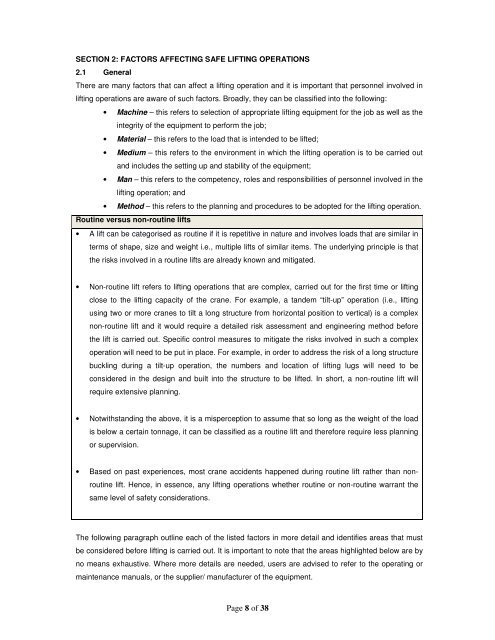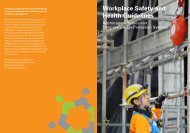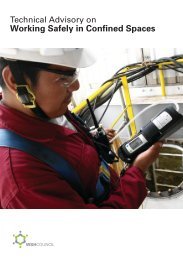Code of Practice - Workplace Safety and Health Council
Code of Practice - Workplace Safety and Health Council
Code of Practice - Workplace Safety and Health Council
Create successful ePaper yourself
Turn your PDF publications into a flip-book with our unique Google optimized e-Paper software.
SECTION 2: FACTORS AFFECTING SAFE LIFTING OPERATIONS<br />
2.1 General<br />
There are many factors that can affect a lifting operation <strong>and</strong> it is important that personnel involved in<br />
lifting operations are aware <strong>of</strong> such factors. Broadly, they can be classified into the following:<br />
• Machine – this refers to selection <strong>of</strong> appropriate lifting equipment for the job as well as the<br />
integrity <strong>of</strong> the equipment to perform the job;<br />
• Material – this refers to the load that is intended to be lifted;<br />
• Medium – this refers to the environment in which the lifting operation is to be carried out<br />
<strong>and</strong> includes the setting up <strong>and</strong> stability <strong>of</strong> the equipment;<br />
• Man – this refers to the competency, roles <strong>and</strong> responsibilities <strong>of</strong> personnel involved in the<br />
lifting operation; <strong>and</strong><br />
• Method – this refers to the planning <strong>and</strong> procedures to be adopted for the lifting operation.<br />
Routine versus non-routine lifts<br />
• A lift can be categorised as routine if it is repetitive in nature <strong>and</strong> involves loads that are similar in<br />
terms <strong>of</strong> shape, size <strong>and</strong> weight i.e., multiple lifts <strong>of</strong> similar items. The underlying principle is that<br />
the risks involved in a routine lifts are already known <strong>and</strong> mitigated.<br />
• Non-routine lift refers to lifting operations that are complex, carried out for the first time or lifting<br />
close to the lifting capacity <strong>of</strong> the crane. For example, a t<strong>and</strong>em “tilt-up” operation (i.e., lifting<br />
using two or more cranes to tilt a long structure from horizontal position to vertical) is a complex<br />
non-routine lift <strong>and</strong> it would require a detailed risk assessment <strong>and</strong> engineering method before<br />
the lift is carried out. Specific control measures to mitigate the risks involved in such a complex<br />
operation will need to be put in place. For example, in order to address the risk <strong>of</strong> a long structure<br />
buckling during a tilt-up operation, the numbers <strong>and</strong> location <strong>of</strong> lifting lugs will need to be<br />
considered in the design <strong>and</strong> built into the structure to be lifted. In short, a non-routine lift will<br />
require extensive planning.<br />
• Notwithst<strong>and</strong>ing the above, it is a misperception to assume that so long as the weight <strong>of</strong> the load<br />
is below a certain tonnage, it can be classified as a routine lift <strong>and</strong> therefore require less planning<br />
or supervision.<br />
• Based on past experiences, most crane accidents happened during routine lift rather than nonroutine<br />
lift. Hence, in essence, any lifting operations whether routine or non-routine warrant the<br />
same level <strong>of</strong> safety considerations.<br />
The following paragraph outline each <strong>of</strong> the listed factors in more detail <strong>and</strong> identifies areas that must<br />
be considered before lifting is carried out. It is important to note that the areas highlighted below are by<br />
no means exhaustive. Where more details are needed, users are advised to refer to the operating or<br />
maintenance manuals, or the supplier/ manufacturer <strong>of</strong> the equipment.<br />
Page 8 <strong>of</strong> 38

















